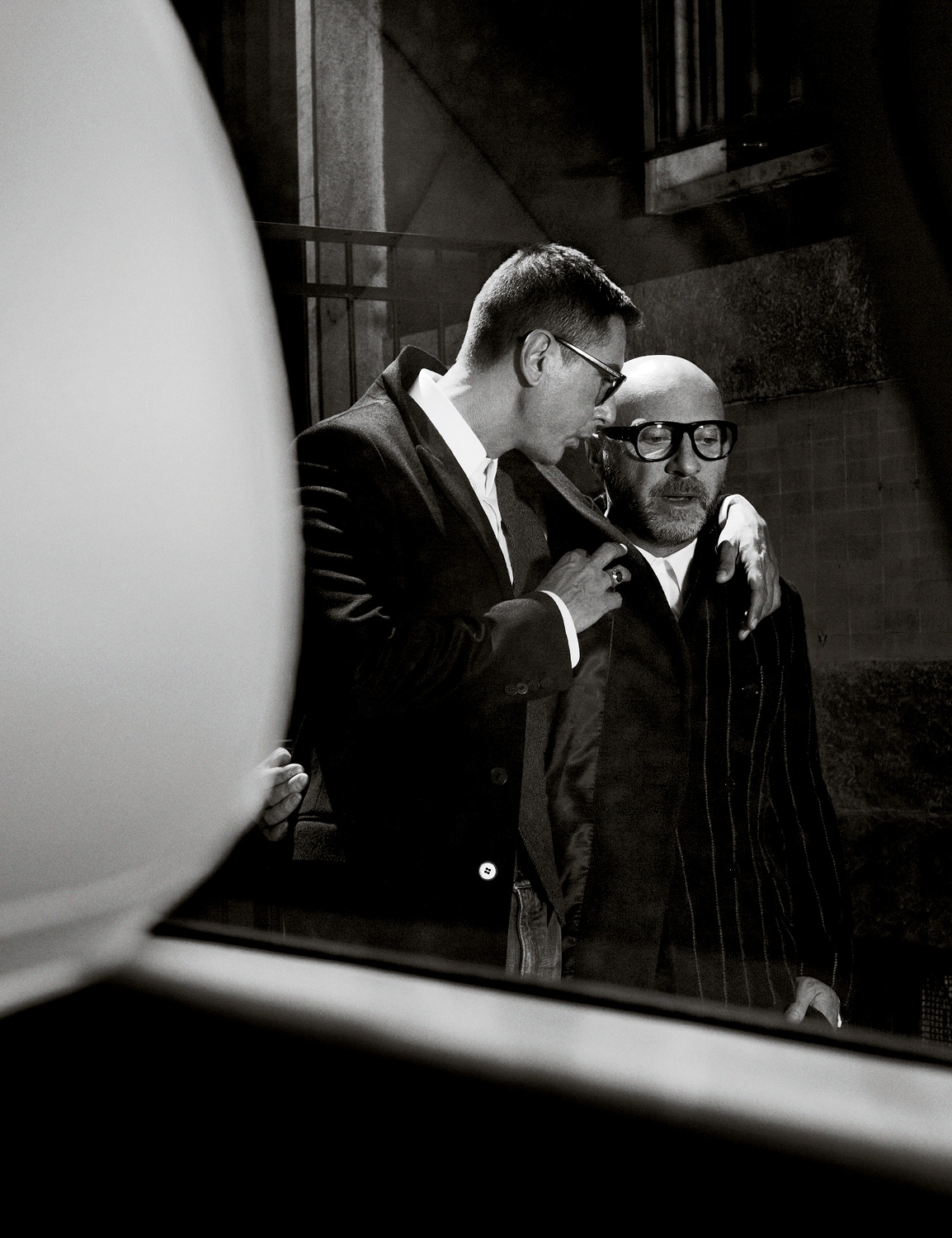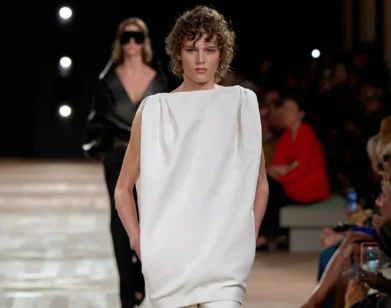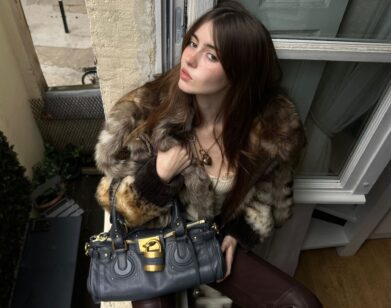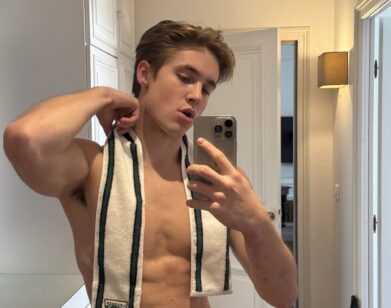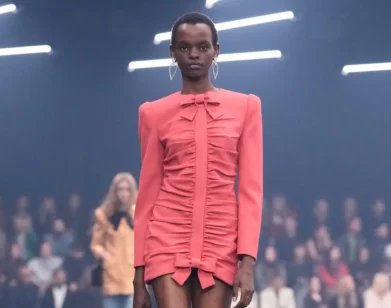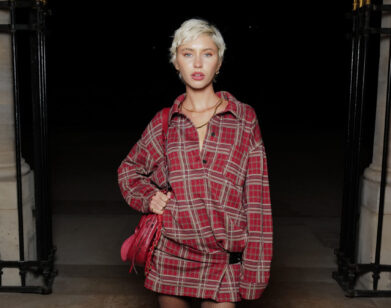Dolce Gabbana
The Fashion industry now has a direct relationship with its customers. thanks to things like twitter, ideas can be shared and circulated.Stefano Gabbana
For their Fall 2011 womenswear collection shown at the Metropol theater in Milan this past February, Domenico Dolce and Stefano Gabbana did a classic riff on the whole mascolino-femminina thing. Tomboy met girlie-girl in 81 looks that ranged from mannishly tailored tuxedos to sexy Sicilian-style evening wear, with a recurrent celestial motif appearing throughout. But what was happening on the catwalk was only part of the story: Dolce & Gabbana also offered a simulcast of the goings-on backstage on giant screens suspended above the catwalk, treating the assembled to an apt demonstration of Gabbana’s last-minute proficiency with a lint roller, among other sundry developments, which was live-streamed on the Internet, along with an instantaneous feed of reactions both from the front row (“So nice to be here!” tweeted one guest) and from around the world (“Love it, love it!” posted an online fan).
While DOLCE & Gabbana have been quick to embrace the social media revolution—they were among the first of the big houses to live-stream their runway show in 2006—the ways in which technology and interconnectivity have collapsed the more traditional boundaries of fashion are more murky. The once rarefied sanctums of shows, presentations, backstage areas, and behind-the-scenes realms have opened up to the world, the relationship between designers and their customers has become more direct, and the more reflective consideration of a collection as a body of work has given way to a kind of piecemeal running commentary on clothes, glitz, and audience in which everyone can participate.
It is in the spirit of this brave, new era in fashion that we at Interview were inspired to conduct a little experiment of our own. We called upon a handful of important friends and followers in the Dolce & Gabbana swirl—Naomi Campbell, Scarlett Johansson, Kylie Minogue, Monica Bellucci, Pat McGrath, Anna Dello Russo, Steven Klein, David Gandy, and Giovanna Battaglia—to help us Interview the designers by working to construct a running dialogue with the duo about their most recent collection, the broader scope of their work and interests, and even aspects of their personal lives, with a couple of special caveats: All questions and answers were to be submitted via e-mail; and none could exceed the magical Twitter-mandated length of 140 characters.
NAOMI CAMPBELL: I’ve always been inspired by the dedication you both have to the brand you created—maintaining its authenticity through each collection.
DOMENICO DOLCE & STEFANO GABBANA: Thank you!
CAMPBELL: It’s well known that the Sicilian woman has always been your muse. Is she still your influence? Where else do you draw your inspiration?
DOLCE: Each of our collections is like a movie. We write the script and this Sicilian woman who has traveled around the world plays the lead role.
GABBANA: DOLCE & Gabbana is like our child. The editing of a collection before a show is a tough call, as we would like to show everything!
DOLCE: Apart from Sicily, which is a starting point, we are inspired by everything—by the world surrounding us, by the times we live in . . .
GABBANA: Also by movies, music, the arts, memories. Everything is filtered and elaborated upon.
INTERVIEW: Did you have a muse for the Fall 2011 collection?
DOLCE: Our muse this season was a woman who is not afraid to dare to mix feminine sensuality with the rigor of masculine cuts.
INTERVIEW: What inspired you to put the girls in boys’ clothes?
GABBANA: In this collection, we liked the idea that glamour could tell the story of a gender mix. Which also mirrors the times we live in.
PAT MCGRATH: Androgyny has always been a big obsession for you. Who is your favorite androgynous muse?
DOLCE & GABBANA: Madonna!
INTERVIEW: Which do you prefer, tough girls or girlie-girls?
DOLCE: I have always liked the tough ones. But a girlie woman is irresistible . . .
GABBANA: Girlie-girls can be tough, and tough girls can be girlie, so it works both ways.
INTERVIEW: What about all the celestial prints? What role did they play in the collection?
GABBANA: We were interested in stars because, at first, they appear to all look the same, but if you look at each one carefully, you realize they each shine in a different way.
INTERVIEW: You’re always particular about the songs for your shows. How do you pick them?
GABBANA: It’s something instinctive. Sometimes we simply fall in love with a song . . . Anyway, it is always Domenico who chooses the music.
ANNA DELLO RUSSO: You both look at everything and control everything that is Dolce & Gabbana. Will you ever photograph your advertising campaigns?
DOLCE: I don’t know . . . I love too much photography. I’d find this intimidating. I am a collector.
GABBANA: But we’ve been thinking about it. It would be a great challenge to tell the story of the collection the way we conceived it. Why not?
DOLCE: I really admire Helmut Newton. Meeting him and working with him was one of the best things I’ve ever done.
INTERVIEW: What have you seen or heard recently that impressed you?
DOLCE: The Terrence Malick movie The Tree of Life.
GABBANA: The pictures of Woody Allen filming his new movie in Rome. I am looking forward to seeing how he will portray Rome and Italy.
DAVID Gandy: If—or when—Hollywood makes a movie about your lives, whom would you like to see play the lead roles?
GABBANA: For the lead roles, I would love to see two people who are talented unknowns, just like we were when we started . . .
DOLCE: I wish Fellini were alive to directed it. We have often been inspired by La Dolce Vita [1960].
Gandy: What would the title of your movie be?
DOLCE: Do you think a movie about us would be successful? I’d love if it happened. They could call it La Dolce Gabbana Vita!
Interview: Is there an actress who defines the Dolce & Gabbana woman for you?
DOLCE & GABBANA: Penélope Cruz.
STEVEN KLEIN: Where and how did you two meet?
DOLCE: Many years ago in Milano. We were young and working as assistants at the studio of a designer.
GABBANA: It was the time when we had many dreams and expectations. It was by chance that we met and fell in love . . .
GIOVANNA BATTAGLIA: One day, Santo Stefano e San Domenico will be the designers of the Paradise. Who will be your favorite person to dress there?
GABBANA: Hmmm . . .
BATTAGLIA: You cannot say Madonna, because you guys already dress her here!
DOLCE: Then I would say all those who did not wear Dolce & Gabbana in their lives.
KYLIE MINOGUE: Who or what would you like to come back as in your next life?
DOLCE & GABBANA: Laurel and Hardy.
MCGRATH: I love working with your new makeup collection. What are your favorite beauty products?
GABBANA: I like Passion Duo, our brand-new gloss fusion lipstick. I also like our Illuminator—it’s a glow-illuminating powder.
DOLCE: Our newest [Perfect Finish] Creamy Foundation, the Femme Fatale [Eyeshadow] quad, the Secret Eyes Mascara, the stromboli eyeliner, our brushes . . .
GABBANA: The Sweet Temptations Collection lipstick in ruby, fire, venere, devil, red, ultra, scarlett, and iconic. I also like the Bronzer Animalier.
INTERVIEW: What is the secret to a good partnership?
GABBANA: Respect.
INTERVIEW: What’s your idea of the perfect day?
DOLCE & GABBANA: When we work together with our assistants at the early stages of a new collection.
Interview: When it’s all said and done, is there anywhere that you would like to escape to?
GABBANA: Escape is a word that doesn’t belong to our lifestyle.
SCARLETT JOHANSSON: Then what is the most delicious and extravagant vacation you’ve ever taken?
DOLCE: A vacation we took to Mexico, where we got to know the ancient cultures and the lush nature.
INTERVIEW: What do you love about New York?
DOLCE: The city’s ability to regenerate itself.
GABBANA: I like the Meatpacking District.
MONICA BELLUCCI: What does Italian style mean to you?
DOLCE: To have a sense of tradition, respect for one’s roots, and a sartorial approach.
GABBANA: Italians know that what matters is style, not fashion. Italian style does not have social or age boundaries.
INTERVIEW: What is something that we would never see on a Dolce & Gabbana runway or in a DOLCE & Gabbana collection?
GABBANA: You can never tell where creativity will lead you, although I do not think we will ever see a DOLCE & Gabbana woman hiding her femininity.
INTERVIEW: What’s your biggest vice?
DOLCE: Silence.
GABBANA: To speak too much.
INTERVIEW: What impact do you think the various kinds of social media, like Twitter, have had on fashion?
GABBANA: The fashion industry now has a direct relationship with its customers. Thanks to things like Twitter, ideas can be shared and circulated.
INTERVIEW: Who do you like to Tweet with?
GABBANA: Friends who I share a joke with.
DOLCE: Tweet? I text—and not that much even.
Follow Stefano Gabbana on Twitter by clicking here.

